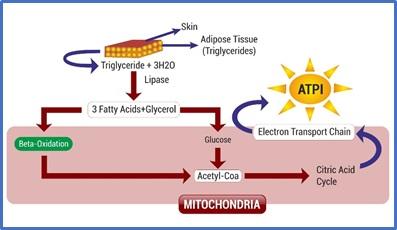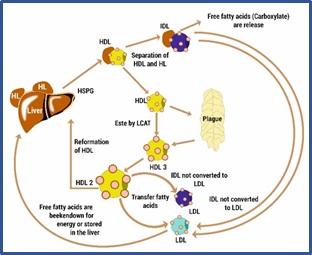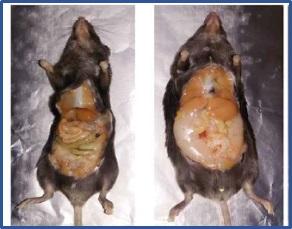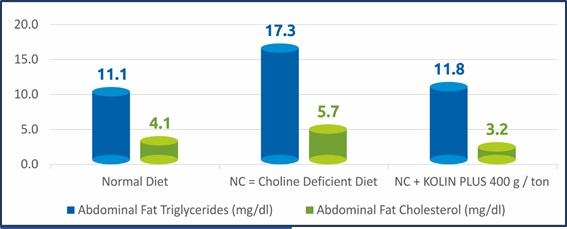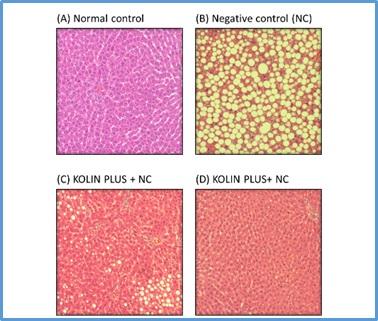Summary
Fat in the poultry body is coming either through feed or through de novo lipogenesis from unused carbohydrates. Gross energy value of fats and oils is 2.25 times more than starch; Therefore, fat metabolism is very crucial for poultry. LIPC also called hepatic lipase is a key enzyme in the liver responsible to break fat into fatty acids. Fatty acids from adipose tissues travel through the blood to other tissues such as muscle where they are oxidized through the mitochondrial beta-oxidation pathway to provide energy. Higher levels of LIPC expression is associated with fatty liver and accumulation of abdominal fat.
Reduction in hepatic and visceral fat is one of the key commercial expectations of choline chloride in poultry nutrition. In choline deficiency, the LIPC gene levels go up. KOLIN PLUS™ down-regulates LIPC gene more intensely than choline chloride (CC) which is correlated with reduction in fat in liver and abdomen effectively. KOLIN PLUS™ is a greener alternative of choline chloride which will give all the benefits of choline chloride but free from its disadvantages.
Fat source in body
Fat in the poultry body is coming either through feed or through de novo lipogenesis from unused carbohydrates. Fat is important in poultry as it is a source of energy, solvent for fat soluble vitamins, reduces the dustiness of feeds and enhance palatability of feed.
Fat digestion
Gross energy value of fats and oils is 2.25 times more than starch (Fat about 9.4 kcal/gm and starch about 4.15 kcal/gm). Therefore, fat metabolism is very crucial for poultry. Digestion of an ingested triglyceride occurs in three steps:
1. Hydrolysis of fat into glycerol and 2 fatty acids by lipase.
2. Micelle formation of fatty acids in the small intestine, facilitated by bile salts.
3. The micelles absorption from the jejunum into portal vein.
Fat metabolism
Chicken stores energy in the body as neutral fats mainly in the adipose tissue like adipocytes, hepatocytes and growing oocytes. Chicken stores small amount of glycogen as energy source in the liver and muscles. Lipase help mobilize the body fat stores by catalysing the production of glycerol and fatty acids. Glycerol is the only portion of triglyceride that can be converted to glucose. Fatty acids from adipose tissues travel through the blood to other tissues such as muscle where they are oxidized through the mitochondrial beta-oxidation pathway to provide energy.
Figure 1: Process of fat metabolism
LIPC and fat metabolism
LIPC also called hepatic lipase is a key enzyme in the liver responsible to break fat into fatty acids. The free fatty acids converts IDL (Intermediate-density lipoproteins) into LDL (Low-density lipoprotein). These remnants of LDL can be sent back to the liver, where it can be stored for later use. (see figure 2) Higher levels of LIPC expression is associated with fatty liver and accumulation of abdominal fat. (see figure 3 showing a rat study from Cedo et al 2017).
Figure 2 showing effect of hepatic lipase (LIPC) on LDL transport to live
HL: hepatic lipase. Hepatic lipase fosters recruitment of LDL to the liver.
Rat expressing LOW LIPC Rat Expressing High LIPC
Figure 3: showing impact of LIPC on liver and abdominal fat (Cedo L et al,2017)
Natural alternative for better fat metabolism
KOLIN PLUS™ is scientifically proven for better fat mobilization, fat metabolism and neurotransmission. These three mechanisms of actions are validated through several in vitro, in vivo and nutrigenomics trials. KOLIN PLUS™ is a Standardized Botanical Powder by Natural Remedies (NR-SBP™).
KOLIN PLUS™ for effective Fat mobilization and metabolism
Reduction in hepatic and visceral fat is one of the key commercial expectations of choline chloride in poultry nutrition. KOLIN PLUS™ is known to reduce liver and visceral fat. (Selvam et al; 2018; AJAS).
Figure 4: In a broiler birds study, choline deficiency was induced by using a specialised diet (negative control). KOLIN PLUS™ and Choline chloride reversed the increase in liver fat induced by choline deficiency.
A: Normal control B : Hepatic steatosis induced by methionine and choline deficient diet C: Negative control + KOLIN PLUS™ 200mg/kg body weight D: Negative control + KOLIN PLUS™ 400mg/kg body weight. The red globules are oil globules stained by a specialised fat stain called Oil Red O.
The molecular mechanisms underlying this effect was elusive, recent genomics studies have indicated the role of ‘’LIPC gene’’ in understanding the fat reducing effects of KOLIN PLUS™.
LIPC & KOLIN PLUS™
In choline deficiency, the LIPC gene levels go up. KOLIN PLUS™ down-regulates LIPC gene more intensely than choline chloride (CC) which is correlated with reduction in fat in liver and abdomen effectively.

Figure 5 showing effect of KOLIN PLUS™ on LIPC gene expression in Broilers ( data expressed as fold change).
NC vs CCD: Gene expression in choline deficiency in comparison to normal control, CCD Vs KP: Gene expression in KOLIN PLUS™ group in comparison to choline deficiency group, CCD Vs CCL: Gene expression in synthetic choline chloride group in comparison to choline deficiency group (CCD: choline chloride deficient , KP : KOLIN PLUS™ , CCL : synthetic choline chloride).
KOLIN PLUS™ controls liver and abdominal fat accumulation by reducing the levels of LIPC, also called hepatic lipase. This partly serves as a molecular mechanism of action for fat reduction by KOLIN PLUS™. KOLIN PLUS™ is a greener alternative of choline chloride which will give all the benefits of choline chloride but free from its disadvantages.
